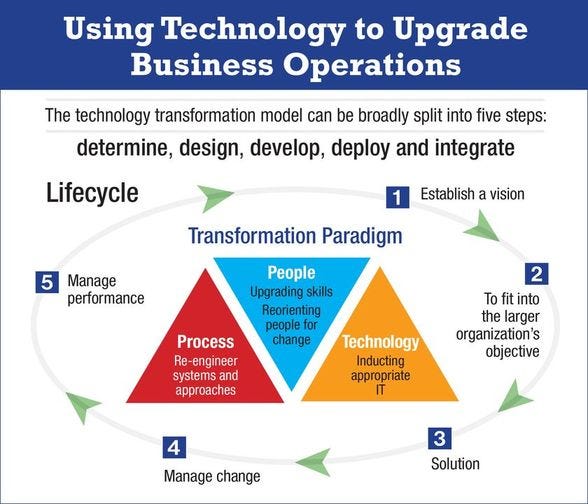Using IT to Transform a Nutrition Brand
Health and nutrition companies need to transform their technology as their business operations change, which can be realized much faster and more efficiently by deploying appropriate information technology (IT) tools.
November 21, 2017

Companies need to re-invent themselves periodically to stay aligned to current trends. Many companies undertake a partial transformation periodically. Once every three years is generally observed to be adequate to keep a company on its toes. Factors driving transformation include high levels of mobile penetration, ever faster access, and democratization of information that is influencing consumer behavior and preference. A misstep of service gone viral on social media has the potential of damaging a brand built painstakingly over time. Reputations can be created and marred almost instantly in this age.
The front end and the back end of the company have to be nimble enough to handle sudden stresses that are inevitable in today’s world of instant communication. Competition has moved from local to global. The playing field between cheaper emerging markets and mature developed markets has leveled. The need to become globally cost competitive has become more important than ever before.
Investors and shareholders are turning global. Options for investing are multiplying as the world is becoming increasingly flat. Shareholders are looking for higher returns and better dividend payouts, and expect companies to deliver increasingly better results. Natural product companies are additionally exposed to volatile commodity input prices and multiplicity of regulation. Many natural product companies cater to the mass market, making them additionally vulnerable to customer complaint risk.
Boards are pushing organizations to make faster changes, become leaner and more competitive, and have healthier balance sheets. Many U.S. corporations, faced with the 2008 financial crisis, realized the imperative to transform early. Information technology (IT) was used as a catalyst to bring the change.
Transformation can be realized much faster and more efficiently by deploying appropriate IT tools. Unlike the past, most technology solutions come with best-in-class embedded business processes. These help introduce more efficient business processes, which result in quantum improvement of efficiency.
Transformation is an integrated play between people, process and technology. All three support and feed into each other. Transformation occurs when the three work in harmony.
Transformation is a continuum, not an event. The transformation model can be broadly split into five steps: determine, design, develop, deploy and integrate.
Determine: The company board—often in consultation with the CEO—sets the company vision. The organization then develops the plan to achieve the set vision. Taking the external and internal ecosystem into consideration, the company operational units and business processes that need to be re-aligned or restructured are identified. Business units whose profit has begun stagnating or where major product re-design is needed are selected for treatment. Business processes, the efficiency of which can be substantially improved by induction of new technology, are listed out for redesign and change. The impact of the proposed changes on the top line, bottom line and human resource is calculated.
Design: Technology plays an important role in the design phase. Business and technology architecture, new technology components, process designs, organization restructuring, manpower redundancy, demobilization plans, new hiring and training plans and retooling programs are designed in this phase. As the technology options are evolving, and the shift is moving toward cloud-based pay-as-you-go back-end and front-end solutions, designs factor the intended impact of the changes into the plans.
Develop: In the last decade, this used to be quite an extensive and time-taking phase. Now, most technology solutions are available off the shelf in a near plug-and-play mode. These solutions require little or no customization. But the additional network and infrastructure support elements required to run the new solutions have to be procured. With modern transformation programs incorporating a heavy dose of technology, preparing the workforce and helping them adapt to the technology changes becomes critical. Change agents from within the organization are identified and trained to be deployed organization-wide to help implement the changes during the deployment phase.
Deploy: The new and transformed organization—with its new business processes supported by technology upgrades—is deployed during this phase. Deployment is often done in a phased manner so the organization gets time to adapt. This is an intense, delicate exercise that requires substantial hand holding. The deployment phase should be implemented with the least possible disruption to organization functioning. Seamless deployment is key to successful implementation.
Integrate: Some of the key elements of the integration phase include post-deployment integration with existing pieces of technology, assimilating the old and newly restructured parts of the organization, providing technical and management support to restructured areas, and gathering transformation performance monitoring from a people, process and technology standpoint. Often in this stage, due to organization change, downsizing of redundant manpower and induction of fresh blood, the organization tends to get unsettled. A jump in attrition is not unusual, and resource management and contingency plans prepared during the design phase may need to be implemented.

While many IT vendors present their technology solutions as total transformation solutions, the reality is a lot of non-IT activity needs to precede and succeed the transformation process. Finding a single organization that can provide both the management advisory and technology implementation support can be difficult. It can therefore be advantageous for natural product organizations to deploy mixed teams. The responsibility of coordinating the activities of two different teams, sometimes hired from different organizations, rests with company management undertaking the transformation exercise.
Successful transformation is observed in companies where the leadership gets intimately engaged with the process.
Sudhir Ahluwalia is a business consultant. He has been management consulting head of Tata Consultancy Services, an IT outsourcing company in Asia, business advisor to multiple companies, columnist and author of upcoming book on herb, “Holy Herbs." He has been a member of the Indian Forest Service.
About the Author
You May Also Like